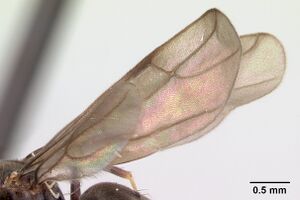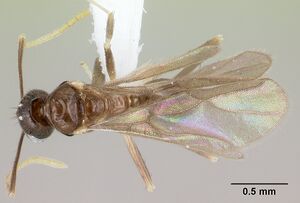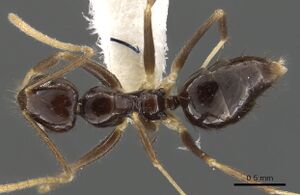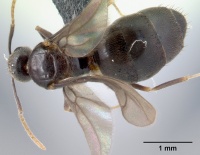Nylanderia lepida
| Nylanderia lepida | |
|---|---|

| |
| Scientific classification | |
| Kingdom: | Animalia |
| Phylum: | Arthropoda |
| Class: | Insecta |
| Order: | Hymenoptera |
| Family: | Formicidae |
| Subfamily: | Formicinae |
| Tribe: | Lasiini |
| Genus: | Nylanderia |
| Species: | N. lepida |
| Binomial name | |
| Nylanderia lepida (Santschi, 1915) | |
| Synonyms | |
| |
Nothing is known about the biology of Nylanderia lepida.
Identification
LaPolla et al. (2011) - Overall darker brown, with distinctly smooth and shining cuticle; mesocoxae and metacoxae whitish, with trochanters and other joints of the legs similarly whitish in color.
Compare with: Nylanderia impolita
In most instances this is an easily identified species, possessing among the shiniest cuticles of any Afrotropical Nylanderia. A few specimens examined exhibited a faintly rugulose cuticle, especially on the head and mesonotum. With these specimens, the cuticular rugosity is always much less defined than is observed in N. impolita. In instances where a faintly rugulose cuticle is observed, the overall size and the length of the scape can effectively separate N. lepida from N. impolita.
Keys including this Species
Distribution
Latitudinal Distribution Pattern
Latitudinal Range: 7.516666667° to -9.534444444°.
| North Temperate |
North Subtropical |
Tropical | South Subtropical |
South Temperate |
- Source: AntMaps
Distribution based on Regional Taxon Lists
Afrotropical Region: Angola, Cameroun (type locality), Central African Republic, Democratic Republic of Congo, Gabon, Ghana, Ivory Coast, Nigeria, São Tomé & Principe, Uganda.
Distribution based on AntMaps
Distribution based on AntWeb specimens
Check data from AntWeb
Countries Occupied
| Number of countries occupied by this species based on AntWiki Regional Taxon Lists. In general, fewer countries occupied indicates a narrower range, while more countries indicates a more widespread species. |

|
Estimated Abundance
| Relative abundance based on number of AntMaps records per species (this species within the purple bar). Fewer records (to the left) indicates a less abundant/encountered species while more records (to the right) indicates more abundant/encountered species. |

|
Biology
Castes
Images from AntWeb

| |
| Queen (alate/dealate). Specimen code casent0086444. Photographer Erin Prado, uploaded by California Academy of Sciences. | Owned by CAS, San Francisco, CA, USA. |
   
| |
| Worker. Specimen code casent0170322. Photographer Estella Ortega, uploaded by California Academy of Sciences. | Owned by CAS, San Francisco, CA, USA. |
   
| |
| Worker. Specimen code casent0179591. Photographer Erin Prado, uploaded by California Academy of Sciences. | Owned by CAS, San Francisco, CA, USA. |
     
| |
| Male (alate). Specimen code casent0217337. Photographer Erin Prado, uploaded by California Academy of Sciences. | Owned by CAS, San Francisco, CA, USA. |
   
| |
| Worker. Specimen code casent0281156. Photographer Cerise Chen, uploaded by California Academy of Sciences. | Owned by PSWC, Philip S. Ward Collection. |
    
| |
| Worker. Specimen code casent0900361. Photographer Will Ericson, uploaded by California Academy of Sciences. | Owned by NHMUK, London, UK. |
Nomenclature
The following information is derived from Barry Bolton's Online Catalogue of the Ants of the World.
- lepida. Prenolepis (Nylanderia) lepida Santschi, 1915c: 262, fig. 11 (w.) CAMEROUN. LaPolla, Hawkes & Fisher, 2011: 19 (q.m.). Combination in Paratrechina (Nylanderia): Emery, 1925b: 218; in Nylanderia: LaPolla, Brady & Shattuck, 2010a: 127. Senior synonym of fuscula, grisoni: LaPolla, Hawkes & Fisher, 2011: 19.
- fuscula. Paratrechina (Nylanderia) grisoni var. fuscula Menozzi, 1942: 178 (w.) EQUATORIAL GUINEA (Bioko I.). [Also given as new in Eidmann, 1944: 460.] Combination in Nylanderia: LaPolla, Brady & Shattuck, 2010a: 127. Junior synonym of lepida: LaPolla, Hawkes & Fisher, 2011: 19.
- grisoni. Prenolepis (Nylanderia) grisoni Forel, 1916: 440, fig. 5 (w.) DEMOCRATIC REPUBLIC OF CONGO. Combination in Paratrechina (Nylanderia): Emery, 1925b: 218; in Nylanderia: LaPolla, Brady & Shattuck, 2010a: 127. Junior synonym of lepida: LaPolla, Hawkes & Fisher, 2011: 19.
Unless otherwise noted the text for the remainder of this section is reported from the publication that includes the original description.
Description
Worker
LaPolla et al. (2011) - Measurements (n = 14): TL: 1.2–2.6; HW: 0.44–0.58; HL: 0.53–0.68; EL: 0.1–0.18; SL: 0.60–0.81; PW: 0.30–0.42; WL: 0.69–0.93; GL: 0.58–0.98
Indices: CI: 78–88; REL: 24–28; SI: 136–152
Overall dark brown with lighter mandibles, antennae, and legs; mesocoxae, metacoxae, trochanters, femurs distally, tibia, and tarsi yellowish to white; area around acidopore yellowish. Cuticle generally smooth and shining, except mesonotum, which is faintly rugulose. Head with scattered pubescence; posterior margin broadly rounded, with distinctly rounded posterolateral corners; scapes surpass posterior margin by about the length of the first three funicular segments; scapes with erect macrosetae (SMC = 12–30) and a layer of pubescence. Pronotum and mesonotum with scattered erect macrosetae of varying lengths (PMC = 3–6; MMC = 2); sparse pubescence on dorsum. Pronotum rounded towards mesonotum; mesonotal area distinct with prominent spiracles; metanotal area elongate; dorsal face of propodeum high and dome-like (higher than mesonotum); dorsal face slightly longer than declivitous face. Gaster shining, with erect macrosetae and occasional pubescence.
Queen
LaPolla et al. (2011) - Measurements (n = 2): TL: 4.1–5.4; HW: 0.71–0.92; HL: 0.76–0.83; EL: 0.31–0.42; SL: 0.81–0.92; PW: 0.95–1.24; WL: 1.2–1.5; GL: 2.2–3.1
Indices: CI: 93–110; REL: 40–50; SI: 100–114
As in worker but with modifications expected for caste. Entire body covered in a dense pubescence; eyes large, but not strongly convex, about half the length of the head lateral margin; scapes and pronotum with no erect setae (PMC = 0); mesonotum and metanotum with scattered erect setae (MMC = 13).
Male
LaPolla et al. (2011) - Measurements (n = 2): TL: 1.6–2.0; HW: 0.45–0.49; HL: 0.47–0.5; EL: 0.21–0.25; SL: 0.52–0.59; PW: 0.47–0.55; WL: 0.52–0.74; GL: 0.63–0.81
Indices: CI: 95–98; REL: 42–50; SI: 117–121
Overall brown, with lighter brown to yellow mandibles, antennae and legs (lightest on trochanters); cuticle smooth and shining. Head with suberect to erect macrosetae and a dense layer of pubescence. Compound eyes large (more than half the length of head lateral margin), strongly convex, surpassing lateral margin in full-frontal view, with ocelli large and raised. Scapes surpass posterior margin by about the length of the first 4 funicular segments; scapes with sparsely scattered, erect macrosetae (SMC = 2–4). Mandible masticatory margin edentate, except for distinct apical tooth; basal angle of mandible distinct. Mesosoma enlarged and modified to accommodate flight muscles; with dense layer of pubescence and scattered erect setae (PMC = 0; MMC = 10); declivity with scattered pubescence, largely smooth and shining. Gaster with pubescence and erect macrosetae. Genitalia: parameres broadly rounded at apices curving dorsally covering most of the dorsal opening; apical margin of parameres emarginate; ventral margin of parameres at an acute angle; cuspi elongated, apices rounded with peg-like teeth on ental surface where they meet digit; digiti apices broad; peg-like teeth at apices dorsally, ventrally coming to a narrow point that curves towards parameres.
Type Material
Holotype worker, CAMEROON: Victoria (Dr. Reichensperger) (Naturhistorisches Museum, Basel) [examined].
Prenolepis (Nylanderia) grisoni 4 syntype workers, D.R. CONGO (Musee d'Histoire Naturelle Genève) [examined].
Paratrechina (Nylanderia) grisoni var. fuscula Holotype worker, EQUATORIAL GUINEA: Fernando Po Island [not examined, depository unknown].
References
- LaPolla, J.S., Hawkes, P.G. & Fisher, B.L. (2011) Monograph of Nylanderia (Hymenoptera: Formicidae) of the World, Part I: Nylanderia in the Afrotropics. Zootaxa 3110: 10–36.
- Emery, C. 1925d. Hymenoptera. Fam. Formicidae. Subfam. Formicinae. Genera Insectorum 183: 1-302 (page 218, Combination in Paratrechina (Nylanderia))
- Santschi, F. 1915c. Nouvelles fourmis d'Afrique. Ann. Soc. Entomol. Fr. 84: 244-282 (page 262, fig. 11 worker described)
References based on Global Ant Biodiversity Informatics
- Braet Y., and B. Taylor. 2008. Mission entomologique au Parc National de Pongara (Gabon). Bilan des Formicidae (Hymenoptera) recoltes. Bulletin S. R. B. E./K.B.V.E. 144: 157-169.
- Eidmann H. 1944. Die Ameisenfauna von Fernando Poo. 27. Beitrag zu den Ergebnissen der Westafrika-Expedition. Zool. Jahrb. Abt. Syst. Ökol. Geogr. Tiere 76: 413-490.
- Forel A. 1916. Fourmis du Congo et d'autres provenances récoltées par MM. Hermann Kohl, Luja, Mayné, etc. Revue Suisse de Zoologie 24: 397-460.
- LaPolla J. S.; P.G. Hawkes, and B.L. Fisher. 2011. Monograph of Nylanderia (Hymenoptera: Formicidae) of the World, Part I: Nylanderia in the Afrotropics. Zootaxa 3110: 10-36.
- Menozzi C. 1942. Formiche dell'isola Fernando Poo e del territorio del Rio Muni (Guinea Spagnola). 24. Beitrag zu den wissenschaftlichen Ergebnissen der Forschungsreise H. Eidmann nach Spanisch-Guinea 1939 bis 1940. Zoologischer Anzeiger 140: 164-182.
- Wheeler W. M. 1922. Ants of the American Museum Congo expedition. A contribution to the myrmecology of Africa. VIII. A synonymic list of the ants of the Ethiopian region. Bulletin of the American Museum of Natural History 45: 711-1004
- Yanoviak S. P., B. L. Fisher, and A. Alonso. 2007. Arboreal ant diversity (Hymenoptera: Formicidae) in a central African forest. African Journal of Ecology. 46(1): 60-66.

